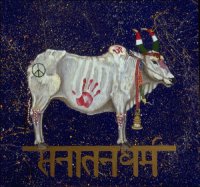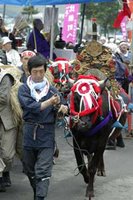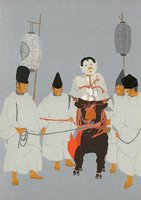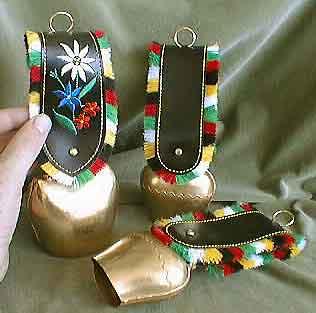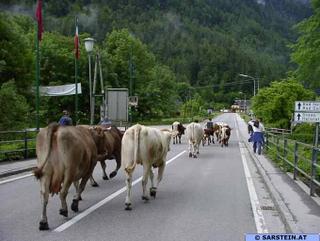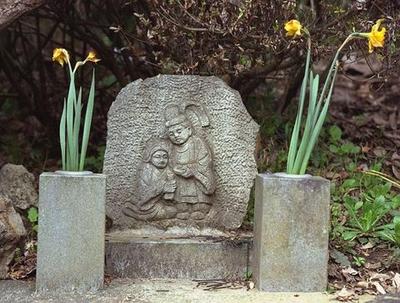:::::::::::::::::::::::::::::::::::::::::::::::::::::::::::::::::::::::::::::::::::::::::::::::::::::
Cherry Blossoms (sakura)
***** Location: Japan
***** Season: Spring, mostly late spring
***** Category: Plant
*****************************
Explanation

Click photo for enlargement.
http://wadaphoto.jp/sakura/yoshino1.htm
:::::::::::::::::::::::::::::::::::::::::::::::::::::::::::::::::::::::::::::::::::::::::::::::::::::
- Matsuo Basho told his disciples:
"Imagine the spring mists over the north bank of the Wei River
when you are standing under the cherry blossoms on the Nerima Hills."
"The north bank of the Wei river" implies the place where Du-Fu once lived.
source : Peipei Qiu: Basho and the Dao
. Chinese background of Japanese kigo .
:::::::::::::::::::::::::::::::::::::::::::::::::::::::::::::::::::::::::::::::::::::::::::::::::::::
kigo for mid-spring
hatsubana 初花 (はつはな) first cherry blossoms
..... hatsuzakura, hatsu zakura 初桜(はつざくら)
higanzakura 彼岸桜 (ひがんざくら) sakura at the spring equinox
uba higan 姥彼岸(うばひがん) Azuma higan 東彼岸(あずまひがん)
tachi higan 立彼岸(たちひがん)
shidarezakura 枝垂桜 (しだれざくら) hanging cherry branches
"weeping cherry"
..... 糸桜(いとざくら)rope cherry
..... shidarizakura しだり桜(しだりざくら)
shidare higan 枝垂彼岸(しだれひがん)
beni shidare 紅枝垂(べにしだれ)red weeping cherry
:::::::::::::::::::::::::::::::::::::::::::::::::::::::::::::::::::::::::::::::::::::::::::::::::::::
cherry blossoms, cherry blossom, hana 花
..... sakura 桜 さくら
kigo for late spring
HANA is the ultimate symbol for the elegance, splendour and fleetingness of things. It can not simple be exchanged for SAKURA in many cases.
For example, hanagokoro, the flower heart, refers to a lady, but you can not say "sakuragokoro" in that case.
"Hana no inochi", the life of flowers, is a general statement, but "sakura no inochi" is not used here.
"capital of blossoms", hana no miyako 花の都
Read : Edo or Kyoto, a discussion of the meaning
:::::::::::::::::::::::::::::::::::::::::::::::::::::::::::::::::::::::::::::::::::::::::::::::::::::
some related kigo of other categories
time for the cherry blossoms, hanadoki 花時 (はなどき)
sakuradoki 桜時(さくらどき), hana no koro 花のころ(はなのころ)
hana no koro 花の頃(はなのころ)
past the cherry blossoms, hana sugi 花過ぎ(はなすぎ)
"Rain on Blossoms" (hana no ame) 花の雨
rain during the time of cherry blossoms, hanadoki no ame
花時の雨(はなどきのあめ)
robes for cherry blossom viewing, hanagoromo 花衣 (はなごろも)
sakuragoromo 桜衣 (さくらごろも)
.. layered robes, sakuragasane 桜重(さくらがさね)
..... hanamigoromo 花見衣(はなみごろも)
kosode robe for cherry blossom viewing,
..... hana no kosode 花の袖(はなのそで),
..... hanami no kosode 花見小袖(はなみこそで)
..... hanami ishoo 花見衣裳(はなみいしょう)
hana no tamoto, 花の袂(はなのたもと)kimono sleeve for blossom viewing
:::::::::::::::::::::::::::::::::::::::::::
cherry blossom, sakura 桜 (さくら)
mountain cherry blossoms, yamazakura 山桜 やまざくら
Yoshino zakura 吉野桜(よしのざくら)Yoshino cherry blossoms
double-petalled cherry blossoms, yaezakura 八重桜 やえざくら
Nara no yaezakura 奈良の八重桜(ならのやえざくら)Nara
late cherry blossoms, osozakura 遅桜 (おそざくら )
falling cherry blossoms, rakka 落花 (らっか)
hana chiru 花散る(はなちる)
sakura chiru 散る桜(ちるさくら)
"blossom blizzard", blossom snowstorm,
hanafubuki 花吹雪(はなふぶき),
sakurafubuki 桜吹雪(さくらふぶき)
cherry blossoms flying around hika 飛花(ひか)
blossom litter, hanakuzu 花屑(はなくず
blossom dust, blossom dirt, hana no chiri 花の塵(はなのちり)

"blossom float" hana ikada 花筏(はないかだ)
when many blossoms hang together on a lake
zanka 残花 (ざんか) remaining cherry blossoms
..... nokoru hana 残る花(のこるはな)
..... nagori no hana 、名残の花(なごりのはな)
..... nokoru sakura 残る桜(のこるさくら)
sakura shibe furu 桜蘂降る (さくらしべふる) cherry petals fall
:::::::::::::::::::::::::::::::::::::::::::::::::::::::::::::::::::::::::::::::::::::::::::::::::::::
more detailes kigo with the cherry blossoms, cherry blooms
related to SAKURA (..zakura in combinations)
Somei Yoshino 染井吉野(そめいよしの)
Miyamazakura 深山桜(みやまざくら)、
Ooshimazakura 大島桜(おおしまざくら)、Ooyamazakura 大山桜(おおやまざくら)、
Botanzakura 牡丹桜(ぼたんざくら)、satozakura 里桜(さとぞくら)、
chawanzakura 茶碗桜(ちゃわんざくら)、naden 南殿(なでん)、
choojizakura 丁字桜(ちょうじざくら)、
mejirozakura 目白桜(めじろざくら)、 mamezakura 豆桜(まめざくら)
Fujizakura 富士桜(ふじざくら)、hahaka ははか、
Uwamizuzakura 上溝桜(うわみずざくら)、
Kongoozakura 金剛桜(こんごうざくら)、
Inuzakura 犬桜(いぬざくら)、shiorizakura しおり桜(しおりざくら)、
Sakon no sakura 左近の桜(さこんのさくら)
uzuzakura 雲珠桜(うずざくら)Uzu cherry blossoms
Yookihizakura 楊貴妃桜(ようきひざくら)"like Yoki-Hi, the Chinese beauty"
shuushikizakura 秋色桜(しゅうしきざくら) "like autumn colors"
cherry blossoms in the morning, asazakura 朝桜(あさざくら)
cherry blossoms in the evening, yuzakura 夕桜(ゆうざくら)
cherry blossoms at night, yozakura 夜桜(よざくら)
full moon and cherry blossoms, sakurazukiyo
桜月夜(さくらづきよ)
"Cherry blossoms on a mountain top",
minezakura 嶺桜(みねざくら)
The ones Basho describes on this trip around Northern Japan on Mt. Gassan are expecially famous. They flower much later than the ones down in the valley. That is why on Mt. Gassan you can experience the three ingredients of Japanese ascetics, Snow, Moon and Cherry blossoms, (Setsugetsuka, Setsugekka 雪月花) at the same time.
SETSUGEKKA, Japanese Art and the Japanese View of Nature
by Isamu Kurita, MOA
cherry blossoms in the garden, niwazakura 庭桜(にわざくら)
around the house, iezakura家桜(いえざくら)
young cherry blossom tree, wakazakura 若桜(わかざくら)
old cherry blossom tree, ubazakura 姥桜(うばざくら)
park with cherry blossom trees,
sakura no sono 桜の園(さくらのその)
related to HANA
hana 花 (はな) (cherry) blossom
"blossom of spring", haru no hana 春の花(はるのはな)
harubana 春花(はるばな)
. hana no kumo 花の雲(はなのくも)
cloud of cherry blossoms .
- - - with haiku by Matsuo Basho
hanabusa 花房(はなぶさ)tuft of cherry blossoms
hanahira 花片(はなびら)cherry petal
hana no sugata 花の姿(はなのすがた)form of the cherry blossom
fragrance of cherry blossoms, hana no ka 花の香(はなのか)
one single cherry blossom, hana no wa 花の輪(はなのわ)
friend to watch cherry blossoms with,
hana no tomo 花の友(はなのとも)
owner of a great cherry blossom tree,
hana no aruji 花の主(はなのあるじ)
garden with cherry blossoms, hana no niwa 花の庭(はなのにわ)
gate with cherry blossoms, hana no mon 花の門(はなのもん)
Kyoto in cherry blossoms, hana no miyako 花の都(はなのみやこ)
hana akari 花明り(はなあかり)"shining cherry blossoms"
still feeling light even in the evening
cherry blossoms at their best, at their peak
hana zakari 花盛り(はなざかり)
花便り(はなだより)、
花の露(はなのつゆ)、花朧(はなおぼろ)、
花の陰(はなのかげ)、花の奥(はなのおく)、
花の名残(はなのなごり)、花を惜しむ(はなをおしむ)
cherry blossom dust, pollen, hana bokori
花埃(はなぼこり)
"flower brocade", hana no nishiki 花の錦(はなのにしき)
color of cherry blossoms, hana no iro
花の色(はなのいろ)
花の粧(はなのよそおい)

straw hat with cherry blossom decoration,
hanagasa 花笠(はながさ)
:::::::::::::::::::::::::::::::::::::::::::::::::::::::::::::::::::::::::::::::::::::::::::::::::::::
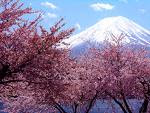
The deity Konohana Sakuyahime 木花開耶姫 lives on Mount Fuji and prevents it from erupting.
Many cherry trees as her symbol have been planted around this mountain.
:::::::::::::::::::::::::::::::::::::::::::::::::::::::::::::::::::::::::::::::::::::::::::::::::::::
Snow, Moon and Blossoms, Setsugekka 雪月花
setsugetsuka
To the Japanese mind, nature is more than just physical scenery.
The Japanese love of the imperfect stems from an acknowledgment of the inherent limitations of human creative powers.
© SETSUGEKKA, by Isamu Kurita, MOA
..... Do not miss to read the full essay .
:::::::::::::::::::::::::::::::::::::::::::::::::::::::::::::::::::::::::::::::::::::::::::::::::::::
HANA, generally meaning FLOWER of any kind, but in spring it is the name for the Cherry Blossom.
Read more about .. Flower and Hana .
hanami 花見 the cherry blossom viewing party
In old times, farmers went out to see the wild cherry trees in the local forest to get a hint at when to start preparing the fields for the rice and how the harvest would be this year. After hanami it was time to tend to the wet rice fields. In many parts of my area, this is still done. In our neighbourhood, where the Daigo Cherry Tree flowers, after the hanami at his feet the farmers look to the forest at a special wild cherry tree to see if its time for the fields.
Since rice farming was essential for surviving in the olden days, HANAMI was the most important festival leading to a good harvest, thus it is not forgotten even today.
The SA from SAKURA is a word leading to the 5. month of the old calender (satsuki) and KURA/GURA comes from KAGURA, the famous dances in Shinto Shrines.
SAKURA is therefore the meaning of a holy dance in May to evoke a good harvest. Now the calender has changed, but the charm of Sakura and flower viewing has stayed with us.
I have written more and introduced some hanami links here:
http://groups.yahoo.com/group/happyhaiku/message/353
Look at my Cherry Viewing Party in April 2005.
Cherry Blossom Road
Cherry Blossoms <> Sakura
Gabi Greve
:::::::::::::::::::::::::::::::::::::::::::::::::::::::::::::::::::::::::::::::::::::::::::::::::::::
hanami kigo for humanity - late spring
(add .. for cherry blossom viewing ... to most of the kigo in English)
hanami 花見 (はなみ) cherry blossom viewing
..... ohanami, o-hanami お花見(おはなみ)
hanamikyaku 花見客(はなみきゃく)visitor for cherry blossom viewing
..... hana no kyaku, 花の客(はなのきゃく), hanamishuu 花見衆(はなみしゅう)crowds
hanabito 花人(はなびと)
hana no en 花の宴(はなのえん)party
hana no sake 花の酒(はなのさけ)、hanamizake 花見酒(はなみざけ)ricewine
hanamidaru 花見樽(はなみだる)barrel full of ricewine
hana no yoi 花の宵(はなのよい) "blossom evening"
hana no maku 花の幕(はなのまく)curtain
..... hana shoogi 花床机(はなしょうぎ)
hana no chaya 花の茶屋(はなのちゃや)teahouse
hanamibune 花見船(はなみぶね)boat
hana no odori 花の踊(はなのおどり)dance
hanamo oogi 見扇(はなみおうぎ)fan
hanami tenugui 花見手拭(はなみてぬぐい)thin hand towel
hanamigasa 花見笠(はなみがさ)strawhat
nahami modori 花見戻(はなみもどり
..... hanamodori 、花戻(はなもどり)
sakuragari 桜狩 (さくらがり) hunting for cherry blossoms
hanameguri, hana meguri 花巡り(はなめぐり)
sakuabito 桜人(さくらびと)
sakurami, sakura mi 桜見(さくらみ)
..... kanoou, kan ou 観桜(かんおう)
hanamushiro 花筵 (はなむしろ) straw mat
..... hanami no seki 花見の席(はなみのせき)
hana moosen 花毛氈(はなもうせん)carpet
hanakagari 花篝 (はなかがり) small bonfire
..... hana bonbori 花雪洞(はなぼんぼり)lantern
hanamori 花守 (はなもり) warden
..... hana no nushi 花の主(はなのぬし)
..... hana no aruji 花の主(はなのあるじ)owner
..... sakuramori,sakura mori 桜守(さくらもり)
hana ikusa 花軍 (はないくさ) fighting, competition
..... hanawawase, hana awase 晩春 花合せ(はなあわせ)
..... hanakurabe, hana kurabe 花比べ(はなくらべ)
hanazukare 花疲 (はなづかれ) getting tired (of watching cherry blossoms)
..... hanamizukare 花見疲(はなみづかれ)
.SAIJIKI ... HUMANITY
Kigo for Spring
.................................................................................

はらはらと
はらはらはらと
桜かな
harahara to
harahara hara to
sakura kana
fluttering
more fluttering
cherry blossoms
- Shared by Taro Aizu -
Joys of Japan, 2012
:::::::::::::::::::::::::::::::::::::::::::::::::::::::::::::::::::::::::::::::::::::::::::::::::::::
There was also an article by Shigeru Awagi dealing with this connection of cherries and rice growing.
SimplyHaiku/SHv2n4/features/Shigeru_Awagi.html
HE48
xxxxxxxxxxxxxxxxxxxxxxxxxxxxxxxxxxxxxxx
From the Cherry Blossom Digest:
Family: Rosaceae
Japanese name for depicting this group: SAKURA
Habitat: mountain area
Height: 3-20m Blooming season: March-May
Prunus yamasakura: Japanese name is YAMAZAKURA (mountain cherries); most popular species in Japan. Often seen in mountainous areas. Red leaves sprout at the same time as pinkish white flowers. Leaves become red again in autumn.
Prunus pendula: Japanese name is EDOHIGAN; leaves sprout after its pinkish white flower blooms. It blooms earlier than other species.
Prunus lannesiana: Japanese name is OOSHIMAZAKURA; green leaves sprout at the same time with white flowers. Its leaves are utilized as Japanese sweets.
Prunus sargentii: Japanese name is OYAMAZAKURA; red leaves sprout at the same time as pink flowers.
Prunus incisa: Japanese name is MAMEZAKURA. Small tree, the height is 3-8m. Leaves and flowers are small too.
Prunus campanulata: Japanese name is HIGANZAKURA; pendulous red flowers bloom in January-March. This is a Chinese cultivar.
Popular cultivars are:
SOMEIYOSHINO: cultivar bred by Prunus pendula x Prunus lannesiana. This is a most popular cultivar, planted in parks and house gardens all over Japan.
SHIDAREZAKURA: cultivar of Prunus pendula; its branches hang down and show flowers like a cascade.
A famous medieval age monk called SAIGYO wrote the following poem about cherry blossom:
"Could I die under a cherry blossom tree in full bloom
on a full-moon night of spring?" (see below)
This poem is popular in Japan because we can feel like the monk when we stand under cherry blossom trees in spring. It is a heavenly experience, as if we are taking a shower of pink flowers.
SAKURA (cherry blossom) is the national flower of Japan, although the floral symbol of the Japanese royal family is KIKU (chrysanthemum).
HANA means flower in Japanese, but we sometimes use HANA for depicting SAKURA, especially in thetraditional literature world.
The Japanese enjoy parties (drinking, eating, and singing a song) under cherry blossom trees in spring and this is called HANAMI (cherry blossom viewing).
SAKURA is a useful tree. We make crafts from SAKURA wood, the leaves are
used for wrapping foods or sweets, and the flowers are used for making fragrant tea called "SAKURA YU".
- source : homepage3.nifty.com/plantsandjapan/page022 -
xxxxxxxxxxxxxxxxxxxxxxxxxxxxx
Here is my special story about the
cherry blossoms of the Yoshino Valley.
http://darumapilgrim.blogspot.com/2005/01/yoshino.html
A list of Japanese Cherry Blossom Festivals
http://groups.yahoo.com/group/happyhaiku/message/1089
LIST OF CHERRY BLOSSOM FESTIVALS IN JAPAN 2005
http://www.thejapaneseconnection.com/newsletters/newsletter_3-17-05_destination.htm
:::::::::::::::::::::::::::::::::::::::::::::::::::::::::::::::::::::::::::::::::::::::::::::::::::::
February 2012
“Sakura: Cherry Blossoms as Living Symbols of Friendship”
Exhibition at Library of Congress
The Library of Congress will celebrate the 100th anniversary of the gift with an exhibition titled "Sakura: Cherry Blossoms as Living Symbols of Friendship," opening on Tuesday, March 20, in the Graphic Arts Galleries on the ground floor of the Thomas Jefferson Building, 10 First St. S.E., Washington, D.C.
source : Library of Congress
*****************************
Worldwide use
Mongolia
. Cherry blossoms “бүйлс” .
Morita san and the Khamar monastery
:::::::::::::::::::::::::::::::::::::::::::::::::::::::::::::::::::::::::::::::::::::::::::::::::::::
USA
Our Cherry Blossoms in Washington DC.
The famous trees, a gift from Japan in 1912, signal the coming of Spring.
The 2005 Cherry Blossom Festival will be March 26-April 10.
Cherry Trees of Washingtonhttp://www.nps.gov/nacc/cherry/index.htm
Carol Raisfeld
:::::::::::::::::::::::::::::::::::::::::::::::::::::::::::::::::::::::::::::::::::::::::::::::::::::
blossom or blossoms
British English versus American English
In the UK we refer to 'blossoms' as the stuff all over the trees in spring, for example cherry blossom, apple blossom, hawthorn blossom, peach blossom. The only time the plural noun would be used is when referring to the collective of these different 'blossoms'.
Otherwise blossoms is only used as a verb
- "the apple tree blossoms in the spring".
CHECk ... www.websters-online-dictionary.org
*****************************
Things found on the way

Sakura Daruma さくら だるま
. sakura さくら / 桜 cherry blossom art motives .
:::::::::::::::::::::::::::::::::::::::::::::::::::::::::::::::::::::::::::::::::::::::::::::::::::::
Haibun
i grew up in washington, dc. the tidal basin, near the jefferson memorial (the potomac river experiences tides as far north as dc) is surrounded by cherry trees, a gift of the japanese people.
my dad, an early rising recreational fisherman and professional photographer, would wait til the peak of the cherry blossom bloom, then rise early to fresh squeeze orange juice into a thermos. then he would bundle the five of us children, still in pajamas and our blankets, into the car and
drive us down to watch the sun rise thru the backlit cherry blossoms. of course, we would sip his fresh squeezed orange juice during this awesome experience.
this haiku, written 50 years later, during a trip to dc during cherry blossom season, was in the Basho festival anthology this year:
cherry petals
breakdancing
on windswells
susan delphine delaney md
plano, texas
xxxxxxxxxxxxxxxxxxxxxxxxxxxxxxxxxx
Paris
As we walked in Paris on Good Friday, we noticed the usual morning-time flood approaching in the gutter alongside the kerb, carrying with it whatever debris the road sweepers had swept up. Only this time, the water carried a flood of pink froth -- we stopped in amazement -- cherry petals far from the trees -- and the flood of water so pretty that morning...
Down in the gutter
look -- a river of petals
-- cherry blossom time.
What joy it was!
Isabelle Prondzynski
xxxxxxxxxxxxxxxxxxxxxxxxxxxxx
© Photo by Gabi Greve
Take part of my Cherry Blossom Viewing Party (hanami) at the Castel Park in Tsuyama in 2005.
Gabi Photo Album
Check also the Hanami photos in Tsuyama from other years, same album.
.................................................................
Saigyo Hooshi, maybe the most famous of the SAKURA poets.
Read about
Saigyo Hooshi (西行法師) and the Cherry Blossoms
.................................................................
sakurafubuki
下り上り 桜吹雪の 道ありて

walking down
and up again -
cherry blossoms scattering
Gabi Greve, Spring 2007
*****************************
HAIKU
sensei nakunarite wa tada no sakura kana
the master being dead
just ordinary...
cherry blossoms
sato no ko no tamoto kara chiru sakura kana
trickling from
a village child's sleeve...
cherry blossoms
sawagashiki yo o oshi haratte oso-zakura
the cure for
this raucous world...
late cherry blossoms
花さくや目を縫れたる鳥の鳴
hana saku ya me o nuwaretaru tori no naku
cherry blossoms--
chickens with eyes stitched shut
are clucking
Jean Cholley explains that this is a scene in the poultry market in the Muromachi district of Edo (today's Tokyo). The birds' eyes were sewn shut to keep them immobile while being fattened in their cages; En village de miséreux: Choix de poèmes de Kobayashi Issa (Paris: Gallimard, 1996) 237. Issa's heart goes out to the birds not only because they are not long for this world. They cannot see, and never again will see, the cherry blossoms.
Issa has more than 120 haiku about Sakura.
..... Tr. David Lanoue
.............................................................................
大馬に尻こすらるる桜哉
oouma ni shiri kosuraruru sakura kana
cherry tree
rubbed by the rump
of a big horse
rubbed rubbing
between cherry tree
and big horse rump
This hokku is from the second month (March) of 1818, when Issa was back in his home town or traveling near it. It's a single statement leading up to the cherry tree, and the passive voice puts a lot of emphasis on the tree trunk being rubbed by a large horse. Issa is empathizing with the tree here and imagining how it must feel -- a sense of wonder that isn't hyperbole, since in Japanese Buddhism grasses and trees were believed to be capable of achieving enlightenment (soumoku-joubutsu 草木成仏).
The above is a standard vanilla translation based on the assumption that Issa regarded the rubbing to be instrumental and done in one direction only, from the horse to the tree. However, that way of reading the hokku probably underestimates Issa's multivalent way of viewing the universe. It also overlooks an interesting ambiguity here: shiri, meaning 'rump' when referring to the horse (translation 1), can refer to the tree as well: shiri means not only 'hips, rump' but also 'back or bottom end or part,' and ki-jiri means the lower trunk of a tree. In translation 2 the cherry tree's lower trunk (shiri) is simultaneously being rubbed by the horse's rump (shiri) and rubbing the rump -- or, from the horse's point of view, causing its rump to be rubbed.
Because of the passive voice in the verb, both the tree and the horse are actively passive and passively active. The main focus seems to be on the uncanny mutual passive-active rubbed-rubbing relationship that is briefly shared by two different beings. I wonder if Issa didn't deliberately try to obscure the subject/object relationships here and intend the hokku to be read both ways, back and forth open-endedly like a moebius strip running between two different forms of consciousness. Probably translation 2 should be the first translation.
It's not clear whether any cherry blossoms are falling because of the rubbing. The tree is probably beginning to bloom at this time, but if petals were falling, it would probably be mentioned, since that's a very important image. In any case, Issa may take this kind of tactile blossom viewing/rubbing to be just as meaningful as human blossom-viewing, if not more meaningful in its own intimate way.
Chris Drake
. Revision of the Comment - August 27, 2013 .
:::::::::::::::::::::::::::::::::::::::::::::::::::::::::::::::::::::::::::::::::::::::::::::::::::::
- - - - - Matsuo Basho - - - - -
さまざまのこと思ひ出す桜かな
samazama no koto omoidasu sakura kana
calling to mind
all manner of things
cherry blossoms
source : Hasegawa Kai
Myriads of things past
Are brought to my mind
These cherry blossoms!
Tr. Ueda
source : www.squidoo.com/
How many, many things
They bring to mind --
Cherry blossoms!
Basho
www.thejapaneseconnection.com/
so many things
that I remember -
these cherry blossoms
Tr. Gabi Greve
hana no kumo kane wa Ueno ka Asakusa ka
cloud of blossoms
is that the bell from Ueno
or Asakusa?
. Matsuo Basho 松尾芭蕉 - Archives of the WKD .
:::::::::::::::::::::::::::::::::::::::::::::::::::::::::::::::::::::::::::::::::::::::::::::::::::::
- - - - - Yosa Buson - - - - -
花に暮れて我家遠き野道かな
hana ni kurete waga ie tooki nomichi kana
Among the blossoms, it grows late,
And I am far from home –
This path over the moor.
Tr. Blyth
With cherry blossoms ends the day
My house, distant--
A path through a field.
Tr. Nelson/Saito
Cherry blossoms darkening,
and far away from my home
on a path through fields!
Tr. Sawa/ Shiffert
(- Buson in Kyoto near Sanjo Ohashi Bashi bridge 三条大橋 - )
花にくれぬ我住む京に帰去来(かえりなん)
hana ni kurenu waga sumu kyo ni kaeri nan (kaerinan)
Darkness on the blossoms --
back to Kyoto where I live
now I will return.
Tr. Sawa/ Shiffert
With respect to a poem by
. Tao Yuanming 陶淵明 .
one of Buson's favorite poets.
Yuanming refers to going home where the chrysanthemums are blossoming.
海手より日は照(てり)つけて山ざくら
雲を呑みて花を吐くなるよしの山
花の香や嵯峨のともしび消ゆる時
(注)視覚と嗅覚の微妙な関係を詠む。遠くの灯が消えて、桜の香りがした。
花を踏みし草履も見えて朝寝かな
月光西にわたれば花影東に歩むかな
. Yosa Buson 与謝蕪村 in Edo .
:::::::::::::::::::::::::::::::::::::::::::::::::::::::::::::::::::::::::::::::::::::::::::::::::::::
天地をわが宿にして桜かな
ame tsuchi o waga yado ni shite sakura kana
heaven and earth
are their home -
these cherry blossoms
Hasegawa Kai
:::::::::::::::::::::::::::::::::::::::::::::::::::::::::::::::::::::::::::::::::::::::::::::::::::::
jinrikisha sakura no namiki toori ni keri
A rikshaw-ride
Along the cherry blossom alley -
What a night!
Mit der Rikshaw
Durch die Kirschbluetenalee -
Was fuer eine Nacht!
Gabi Greve in Kamakura, along the Dankazura Sakura Alley
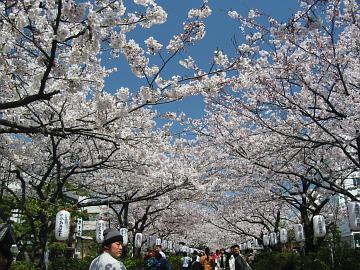
.. .. .. .. .. .. .. .. Kamakura
http://www5b.biglobe.ne.jp/~takei/kamakura200304/sakura-03.jpg
xxxxxxxxxxxxxxxxxxxxxxxxxxxxx
the cat
cherry blossoms
on her tail
in her tea
a fallen petal
cherry blossom
Geert Verbeke
http://happyhaiku.blogspot.com/2004/01/friends-geert-verbeke.html
xxxxxxxxxxxxxxxxxxxxxxxxxxxxx
blossoms swirl . . .
the puppy plays
with a petal
Carol Raisfeld
xxxxxxxxxxxxxxxxxxxxxxxxxxxxx
© Photo by Gabi Greve
falling petals -
the farmers wife
spraying chemicals
Read more about the rural Sakura of Gabi Greve
http://happyhaiku.blogspot.com/2005/03/cherry-blossoms-sakura.html
*****************************
Related words
***** . Autum Cherry Shikizakura (Japan)
***** Daigo Cherry Tree Daigo-zakura, Western Japan
***** Light Charcoal Cherry Blossoms, Usuzumizakura 薄墨桜 and a Kannon Statue
***** himuro no sakura 氷室の桜
cherry blossoms in the ice house
***** late cherry blossoms, lingering cherry blossoms
yoka (よか) 余花
wakaba no hana 若葉の花(わかばのはな)cherry "blossoms among young leaves"
..... aoba no hana 青葉の花(あおばのはな)
natsuzakura 夏桜(なつざくら) summer cherry blossoms
hazakura 葉桜 (はざくら) "leaves and blossoms"
It has a feeling of the quiet after the storm, of time taking its move from one thing to the next.
!! kigo for early summer !!
This kigo refers not to the last blossoms of a tree flowering in spring usually, but to the late blossoms up on the mountains, especially in Yoshino Valley. The blossoms are full of vigour and beauty.
climbing for hours
with sweat on my brow -
late cherry blossoms !
Gabi Greve, Yoshino, 1988

***** cherry, the fruit 桜の実 (さくらのみ) sakura no mi
mizakura 実桜(みざくら)
sakura mi to naru 桜実となる(さくらみとなる) cherry becomes a fruit
sakuranbo さくらんぼ
:::::::::::::::::::::::::::::::::::::::::::::::::::::::::::::::::::::::::::::::::::::::::::::::::::::
Yoshino Yama shizuka ni yoka no owarikeri
Mount Yoshino !
quietly the last cherry blossoms
come to an end
(Tr. Gabi Greve)
荒木 春雪子
(NHK Haiku, May 6, 2006)
http://www.nhk.or.jp/tankahaiku/haiku_tokusen/index_week.html
:::::::::::::::::::::::::::::::::::::::::::::::::::::::::::::::::::::::::::::::::::::::::::::::::::::
Cherry Blossom Time ... Food Kigo
:::::::::::::::::::::::::::::::::::::::::::::::::::::::::::::::::::::::::::::::::::::::::::::::::::::
[ . BACK to DARUMA MUSEUM TOP . ]
[ . BACK to WORLDKIGO . TOP . ]
:::::::::::::::::::::::::::::::::::::::::::::::::::::::::::::::::::::::::::::::::::::::::::::::::::::

